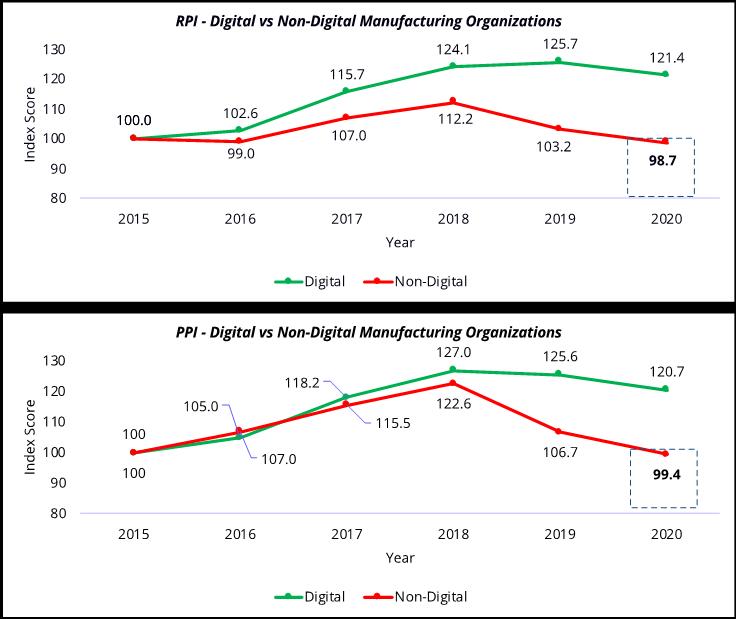Digitally mature manufacturers outperform their non-digital peers — they generate more revenue and profit, and will out-compete non-digital companies. This is a bold statement, but it was a clear outcome of recent IDC Worldwide Manufacturing Insights research, which compared the profitability and revenue of digitally mature manufacturers to their non-digital counterparts over the last six years. Disruptions caused by trade tensions and the global pandemic had a smaller impact on manufacturers that had just started or were well on their digital transformation (DX) journey compared to non-digital manufacturers (see Figure 1 below).

The real learning here is that companies on their DX journey can better navigate difficult periods and disruptions at company, industry, and global levels due to better digital resiliency. These companies can control all aspects of their operations, utilize data to understand risks from multiple scenarios, make data-driven decisions, predict the outcomes of specific actions and make optimal, intelligent decisions.
Digital transformation is cumulative
The essential first step in the DX journey for manufacturers is recognizing that DX is necessary. However, the actual value of advanced technology use is not in adopting, for example, a single system. The technologies implemented need to create a foundation for future capabilities, beginning with the data framework upon which the organization can innovate products and processes and create opportunities in markets and ecosystems in which they operate. For example, while an order processing system automates and optimizes business processes related to resources required to meet organizational objectives, it can also be a foundation for extending capabilities to a thinking supply chain:
- ERP becomes one essential part of a system that connects the entire supply chain and end-to-end innovation, from the consumer to raw materials supplier, to drive overall performance.
- Performance optimization does not happen in one project but rather as part of a series of deployments that layer technological capabilities over time.
- Many problem statements faced by manufacturers are inherently complex and non-linear and defy traditional statistical methods, so as additional data capabilities are added, artificial intelligence becomes crucial to process the volume of data.
This means starting with use cases that facilitate end-to-end data integration and dashboarding, then building up additional forecasting, scenario analysis, predictive, and optimization capabilities from the organizational level to across the supply chain.
Manufacturers use analyst predictions and trends within the context of their organizational goals and strategies to develop a DX roadmap, which is crucial to plan technology decisions that layer capabilities as they advance from one project to the next. The examples below show how DX projects are cumulative, with greater and greater value being derived as the journey progresses.

The technology roadmap is developed alongside organizational strategy, providing a framework for future business model innovation and growth. Alignment of the roadmap with enterprise strategy allows manufacturers to focus on today’s problems, with an eye to ensuring data capabilities support future business outcomes.
Understanding digital maturity unlocks digital deadlocks
Manufacturers designing a business for the future need to assess their current capabilities and determine where they are in relation to future strategies, competitors, and market trends. Unlocking digital deadlocks requires organizations to:
- Identify siloed initiatives and the opportunities to integrate data and digital capabilities into the rest of the digital roadmap
- Evaluate KPIs, and evaluate them alongside new metrics that will indicate alignment between and progress towards the organization's digital and corporate strategies
- Determine gaps in the expertise and capabilities necessary to drive performance in the short- and long-term.
- Determine priorities for tactical plans to drive improvement to business operations in the short- to mid-term
- Create a vision for a future enterprise and ensure the digital roadmap builds a foundation that delivers on tactical requirements, but which allows for future growth.
Learn more
Register below to watch the IDC and SAS webcast on demand, and watch out for the next blog post, which will elaborate on more specific use cases that manufacturers can combine to deliver on immediate priorities while enabling data capabilities for the future.
Register for IDC, SAS & Intel Smart Manufacturing On Demand Webcast

